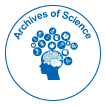Quantum Computing: The Next Frontier in Scientific Innovation
Received: 01-Mar-2025 / Manuscript No. science-25-168758 / Editor assigned: 03-Mar-2025 / PreQC No. science-25-168758(PQ) / Reviewed: 17-Mar-2025 / QC No. science-25-168758 / Revised: 22-Mar-2024 / Manuscript No. science-25-168758(R) / Published Date: 28-Mar-2025
Abstract
Quantum computing is poised to revolutionize science and technology by harnessing the principles of quantum mechanics to perform computations far beyond the reach of classical computers. This article introduces the foundations of quantum computing, including qubits, superposition, and entanglement, and highlights its transformative potential across domains such as cryptography, material science, drug discovery, and climate modeling. The discussion also addresses current technological limitations, progress in quantum hardware, and the implications of achieving quantum supremacy. As global investment surges, quantum computing is emerging as a pivotal field reshaping our understanding of computation and problem-solving.
Keywords
Quantum computing; Qubits; Quantum supremacy; Superposition; Entanglement; Quantum algorithms; Quantum hardware; Cryptography; Material science; Scientific computing
Introduction
Quantum computing, once considered a theoretical curiosity, is now advancing rapidly toward practical implementation. Unlike classical computers, which operate using bits that represent either a 0 or 1, quantum computers use quantum bits or "qubits" that can exist in superposition—simultaneously representing 0 and 1. This property, along with entanglement and quantum interference, enables quantum systems to process and store information in ways that exponentially surpass classical limits [1]. First conceptualized by physicists like Richard Feynman and David Deutsch in the 1980s, quantum computing has now evolved into a multidisciplinary frontier involving physics, computer science, engineering, and information theory.
Description
The foundation of quantum computing rests on several core principles of quantum mechanics. Superposition allows qubits to exist in multiple states simultaneously, exponentially expanding the computational state space. Entanglement enables correlations between qubits such that the state of one immediately affects the state of another, even across large distances [2]. Quantum gates manipulate these qubits to perform calculations through quantum circuits, which differ fundamentally from classical logic gates.
Quantum algorithms, such as Shor’s algorithm for integer factorization and Grover’s algorithm for unstructured search, exemplify quantum computing's potential to outperform classical systems. Shor’s algorithm, for example, can factor large numbers exponentially faster than the best-known classical algorithms, posing a threat to widely used cryptographic systems like RSA [3]. This has prompted a global effort to develop quantum-resistant encryption standards.
In the realm of scientific discovery, quantum computing is set to transform computational chemistry and material science. Simulating the behavior of molecules and quantum systems is computationally intensive and often intractable for classical computers. Quantum systems, by contrast, can natively represent these phenomena, enabling the simulation of complex interactions in drugs, catalysts, and novel materials [4].
Quantum computing also offers powerful tools for optimization problems, which are central to logistics, finance, and artificial intelligence. By exploring multiple solutions simultaneously, quantum algorithms can find optimal paths or configurations in systems with massive solution spaces. Applications include traffic flow optimization, portfolio management, and machine learning model training [5].
Results
Recent years have witnessed significant milestones in quantum computing. In 2019, Google claimed to have achieved "quantum supremacy" when its 53-qubit processor, Sycamore, completed a task in 200 seconds that would take the best classical supercomputer 10,000 years [6]. While this specific task had no practical use, it marked a major step in demonstrating the computational power of quantum systems.
IBM, IonQ, Rigetti, and other companies have also developed quantum processors with increasing numbers of qubits, connectivity, and coherence time. IBM’s roadmap projects the deployment of 1,000+ qubit systems by 2025, with the aim of achieving fault-tolerant quantum computing [7]. On the software side, platforms like Qiskit, Cirq, and Microsoft’s Q# provide tools for researchers and developers to design, simulate, and run quantum algorithms on both real and emulated devices.
In drug discovery, companies such as Qubit Pharmaceuticals and Zapata Computing are using hybrid quantum-classical workflows to accelerate molecule screening and identify binding affinities with unprecedented precision. In material science, quantum simulations are being used to study high-temperature superconductors, lithium-ion battery improvements, and carbon capture materials [8].
Despite these advancements, quantum computing remains in the early stages. Current devices are noisy intermediate-scale quantum (NISQ) systems that are limited in qubit number and prone to decoherence and operational errors. Error correction protocols and the development of stable qubits using technologies such as superconducting circuits, trapped ions, and topological qubits are areas of active research [9].
Conclusion
Quantum computing holds the promise of transforming our computational capabilities and unlocking solutions to some of the most complex problems in science and engineering. Its impact spans cryptography, drug design, climate prediction, and optimization. While substantial technical hurdles remain—including error correction, qubit scalability, and algorithm development—ongoing research and investment from academia, industry, and governments are driving progress at a remarkable pace. As we approach the era of practical quantum advantage, it becomes increasingly important to ensure secure and equitable access to quantum technologies and to consider their societal implications. Quantum computing is no longer just a theoretical ideal—it is rapidly becoming a central tool in the scientific arsenal of the future.
Citation: Kavita RC (2025) Quantum Computing: The Next Frontier in ScientificInnovation. Arch Sci 9: 274.
Copyright: © 2025 Kavita RC. This is an open-access article distributed under theterms of the Creative Commons Attribution License, which permits unrestricteduse, distribution, and reproduction in any medium, provided the original author andsource are credited.
Select your language of interest to view the total content in your interested language
Share This Article
Open Access Journals
Article Usage
- Total views: 332
- [From(publication date): 0-0 - Dec 08, 2025]
- Breakdown by view type
- HTML page views: 249
- PDF downloads: 83
